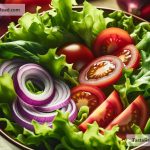Embrace the Minimal: Mastering White Space in Food Photography
In the realm of food photography, the power of simplicity cannot be understated. Among the various techniques to achieve a clean and appealing aesthetic, the strategic use of white space has emerged as a cornerstone. This isn’t about capturing just the allure of a dish, but about telling a story, evoking emotion, and creating an irresistible invitation to the viewer. Today, let’s embark on a journey to understanding how white space can transform your food photography, giving it that pristine, minimalistic charm.
What is White Space?
Before diving in, let’s clear up a common misconception. White space doesn’t necessarily mean blank, white areas. It refers to the unoccupied or negative space around and between the subjects of an image. This space doesn’t have to be white; it can be any color, texture, or backdrop that provides a visual breathing room. Its purpose? To draw attention directly to the main subject, making the food the undeniable star of the show.
The Benefits of Using White Space
Why go minimal? The benefits are plentiful:
- Focus: White space eliminates clutter, directing the viewer’s attention to the dish.
- Mood and Tone: It can convey elegance and sophistication, making your images more appealing to high-end clients or brands.
- Versatility: Such images blend seamlessly into various layouts (think magazines, menus, or blogs), providing room for text or other design elements.
How to Effectively Use White Space in Food Photography
1. Plan Your Composition
Start with intention. Decide what story you want to tell with the dish. Should it convey warmth and abundance, or sophistication and exclusivity? Your answer will guide whether your white space should be vast and expansive or minimal yet impactful.
2. Choose Your Background Wisely
The backdrop is pivotal in creating effective white space. Opt for neutral tones that complement the dish without competing for attention. Textured surfaces like linen or a rustic wooden table can add depth and interest without overwhelming the viewer.
3. Harness the Power of Lighting
Natural light is your ally in highlighting the food while maintaining a clean look. Soft, diffused light accentuates textures and colors, giving the dish a jewel-like quality against the serene backdrop of white space.
4. Embrace Asymmetry
Centralized compositions are classic, but placing your subject off-center can make your photo more dynamic. Apply the rule of thirds: envision your image divided into nine equal segments by two vertical and two horizontal lines. Positioning the food along these lines or their intersections creates balance and engages the viewer.
5. Simplify the Scene
In food photography, less is often more. Resist the urge to overcrowd the scene with too many props or ingredients. Select a few key elements that complement the dish, either by echoing its colors, textures, or theme, and space them out strategically.
6. Experiment with Angles
Different angles can dramatically alter the amount of white space and its impact. Overhead shots create a flat, unified field, ideal for bold, graphic compositions. Meanwhile, shooting from a lower angle might concentrate the white space in one area of the photo, guiding the eye in a specific direction.
7. Edit With a Light Touch
In post-processing, resist the temptation to over-saturate colors or add too many effects. The goal is to enhance the natural beauty of the food and maintain the clean, airy feel of the white space. Tweaking the brightness, contrast, and saturation should suffice.
Learning From the Pros
Analyzing the work of accomplished food photographers can provide valuable insights into using white space effectively. Notice how they balance the elements, manipulate light, and convey emotion with minimalism. Platforms like Instagram and Pinterest are goldmines for inspiration and practical examples.
Conclusion
Incorporating white space into your food photography is more than a stylistic choice; it’s a means to communicate the essence of the dish in a refined and compelling manner. By mastering this technique, you create not just images but experiences that resonate with viewers, beckoning them to explore the tastes and textures encapsulated in your photos. Whether you’re a budding photographer or a seasoned pro, embracing the minimalist charm of white space can elevate your work, setting it apart in the vibrant world of culinary artistry.


